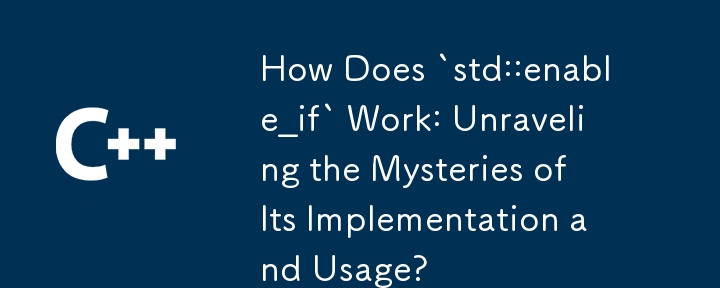`std::enable_if` 是如何運作的:揭開其實現和使用的神秘面紗?

理解std::enable_if:破解其目的和實現
理解std::enable_if:破解其目的和實現雖然std::enable_if 的本質是在某些上下文中掌握的,但它的錯綜複雜的問題,特別是模板語句中的第二個參數和對std::enable_if 的賦值,仍然是個謎。深入研究其工作原理將解開這些謎團。
std::enable_if 的要點template struct enable_if {};
template struct enable_if { typedef T type; }; template
至關重要的是,型別別名 typedef T 型別僅在 Cond 為 true 時定義。
揭示用法template
typename std::enable_if<:numeric_limits>::is_integer, void>::type foo(const T &bar) { isInt(bar); } 模板 型別名稱std::enable_if<:numeric_limits>::is_integer, void>::type foo(const T &bar) { isInt(bar); }
這裡,foo的回傳型別由std ::enable_if<:numeric_limits>::is_integer, void>::type定義。由於 std::numeric_limits
template::value, int>::type = 0>
void foo(const T& bar) { isInt(); } template
= 0 用來預設第二個範本參數。這允許使用 foo
- 明確輸入型別名稱 std::enable_if<:condition t>::type 增強清晰度。
- 在 C 14 中,enable_if_t 是已建立的類型,應用於返回類型,將其簡化為 std::enable_if_t
。

-
 如何在 Golang Web 伺服器中串流 MP4 影片?GoLang Web 伺服器串流影片GoLang Web 伺服器串流影片GoLang Web 伺服器串流影片問:Golang Web 伺服器設定為服務HTML、CSS、JavaScript 和映像失敗嘗試串流式傳輸MP4 視訊。 if contentType == "video/mp4&q...程式設計 發佈於2024-11-14
如何在 Golang Web 伺服器中串流 MP4 影片?GoLang Web 伺服器串流影片GoLang Web 伺服器串流影片GoLang Web 伺服器串流影片問:Golang Web 伺服器設定為服務HTML、CSS、JavaScript 和映像失敗嘗試串流式傳輸MP4 視訊。 if contentType == "video/mp4&q...程式設計 發佈於2024-11-14 -
 Bootstrap 4 Beta 中的列偏移發生了什麼事?Bootstrap 4 Beta:列偏移的刪除和恢復Bootstrap 4 在其Beta 1 版本中引入了重大更改柱子偏移了。然而,隨著 Beta 2 的後續發布,這些變化已經逆轉。 從 offset-md-* 到 ml-auto在 Bootstrap 4 Beta 1 中, offset-md-*...程式設計 發佈於2024-11-14
Bootstrap 4 Beta 中的列偏移發生了什麼事?Bootstrap 4 Beta:列偏移的刪除和恢復Bootstrap 4 在其Beta 1 版本中引入了重大更改柱子偏移了。然而,隨著 Beta 2 的後續發布,這些變化已經逆轉。 從 offset-md-* 到 ml-auto在 Bootstrap 4 Beta 1 中, offset-md-*...程式設計 發佈於2024-11-14 -
 CSS 中的「display: table-column」實際上做了什麼?CSS「display: table-column」該如何運作? 在 HTML 中,表格由行組成,每行含有細胞。 CSS 擴展了這個概念,讓設計者定義特定的行和列佈局。雖然「display: table-row」和「display: table-cell」很簡單,但「display: table-c...程式設計 發佈於2024-11-14
CSS 中的「display: table-column」實際上做了什麼?CSS「display: table-column」該如何運作? 在 HTML 中,表格由行組成,每行含有細胞。 CSS 擴展了這個概念,讓設計者定義特定的行和列佈局。雖然「display: table-row」和「display: table-cell」很簡單,但「display: table-c...程式設計 發佈於2024-11-14 -
 Babel 6 如何以不同的方式處理預設導出?重大變更:Babel 6 匯出預設行為隨著 Babel 6 的發布,預設導出的處理方式發生了重大變化。雖然 Babel 之前新增了 module.exports = Exports["default"] 行,但此功能已被刪除。 此修改需要更改模組導入語法。以前,使用舊語法的程式碼...程式設計 發佈於2024-11-14
Babel 6 如何以不同的方式處理預設導出?重大變更:Babel 6 匯出預設行為隨著 Babel 6 的發布,預設導出的處理方式發生了重大變化。雖然 Babel 之前新增了 module.exports = Exports["default"] 行,但此功能已被刪除。 此修改需要更改模組導入語法。以前,使用舊語法的程式碼...程式設計 發佈於2024-11-14 -
 掌握 Next.js 中的 SSR:如何提升 SEO 與使用者體驗SSR(伺服器端渲染)是 Next.js 中產生頁面的另一種方法。在本文中,我想解釋什麼是 SSR、它是如何運作的,以及如何在 Next.js 專案的 Page Router 和 App Router 中實現它。 什麼是SSR? SSR是一種在使用者發出請求後產生靜態頁面(或預先渲...程式設計 發佈於2024-11-14
掌握 Next.js 中的 SSR:如何提升 SEO 與使用者體驗SSR(伺服器端渲染)是 Next.js 中產生頁面的另一種方法。在本文中,我想解釋什麼是 SSR、它是如何運作的,以及如何在 Next.js 專案的 Page Router 和 App Router 中實現它。 什麼是SSR? SSR是一種在使用者發出請求後產生靜態頁面(或預先渲...程式設計 發佈於2024-11-14 -
 為什麼 PHP 5.2 不允許抽象靜態類別方法?PHP 5.2 嚴格模式:為什麼不允許抽象靜態類別方法? 在 PHP 5.2 中,啟用嚴格警告可能會觸發熟悉的警告:「靜態函數不應該是抽象的」。此警告源自於 PHP 5.2 中引入的一項更改,該更改不允許抽象靜態類別方法。 原因:歷史監督PHP 5.2 最初缺乏後期靜態綁定,使抽象靜態函數變得無用。...程式設計 發佈於2024-11-14
為什麼 PHP 5.2 不允許抽象靜態類別方法?PHP 5.2 嚴格模式:為什麼不允許抽象靜態類別方法? 在 PHP 5.2 中,啟用嚴格警告可能會觸發熟悉的警告:「靜態函數不應該是抽象的」。此警告源自於 PHP 5.2 中引入的一項更改,該更改不允許抽象靜態類別方法。 原因:歷史監督PHP 5.2 最初缺乏後期靜態綁定,使抽象靜態函數變得無用。...程式設計 發佈於2024-11-14 -
 如何為 10 個連續點的每段繪製不同顏色的線?用不同的顏色繪製一條線問題陳述給定兩個列表,latt和lont,目標是繪製一條線,其中每個清單10個連續點的線段以不同的顏色表示。 解決方案解決方案線段數量有限import numpy as np import matplotlib.pyplot as plt # Generate random c...程式設計 發佈於2024-11-14
如何為 10 個連續點的每段繪製不同顏色的線?用不同的顏色繪製一條線問題陳述給定兩個列表,latt和lont,目標是繪製一條線,其中每個清單10個連續點的線段以不同的顏色表示。 解決方案解決方案線段數量有限import numpy as np import matplotlib.pyplot as plt # Generate random c...程式設計 發佈於2024-11-14 -
 如何在 MySQL 中根據計數過濾資料而不使用嵌套 SELECT?MySQL - 在WHERE 子句中使用COUNT(*)使用者在嘗試使用WHERE 子句中的COUNT(*) 函數過濾MySQL 中的資料時遇到了挑戰WHERE 子句。他們尋求一種有效的方法來完成此任務,而不使用巢狀 SELECT 語句,因為它會消耗大量資源。 使用者提供了以下偽代碼來說明他們期望的...程式設計 發佈於2024-11-14
如何在 MySQL 中根據計數過濾資料而不使用嵌套 SELECT?MySQL - 在WHERE 子句中使用COUNT(*)使用者在嘗試使用WHERE 子句中的COUNT(*) 函數過濾MySQL 中的資料時遇到了挑戰WHERE 子句。他們尋求一種有效的方法來完成此任務,而不使用巢狀 SELECT 語句,因為它會消耗大量資源。 使用者提供了以下偽代碼來說明他們期望的...程式設計 發佈於2024-11-14 -
 如何在 Python 中按名稱存取 SQL 結果列值?在Python 中按列名稱存取SQL 結果列值處理資料庫中的大量列時,依賴列索引資料來擷取可能會變得很麻煩。本文透過提供一種在 Python 中使用列名稱檢索 SQL 結果列值的方法來解決對更直觀方法的需求。 解決方案:利用 DictCursor Python 的 MySQLdb 模組提供了 Dic...程式設計 發佈於2024-11-14
如何在 Python 中按名稱存取 SQL 結果列值?在Python 中按列名稱存取SQL 結果列值處理資料庫中的大量列時,依賴列索引資料來擷取可能會變得很麻煩。本文透過提供一種在 Python 中使用列名稱檢索 SQL 結果列值的方法來解決對更直觀方法的需求。 解決方案:利用 DictCursor Python 的 MySQLdb 模組提供了 Dic...程式設計 發佈於2024-11-14 -
 何時使用 Django ORM 的 select_lated 與 prefetch_lated?Django ORM 的 select_lated 和 prefetch_lated 之間的區別在 Django ORM 中,select_lated 和 prefetch_lated 方法在管理資料庫查詢中的關係方面具有不同的用途。 select_latedDjango的select_lated方...程式設計 發佈於2024-11-14
何時使用 Django ORM 的 select_lated 與 prefetch_lated?Django ORM 的 select_lated 和 prefetch_lated 之間的區別在 Django ORM 中,select_lated 和 prefetch_lated 方法在管理資料庫查詢中的關係方面具有不同的用途。 select_latedDjango的select_lated方...程式設計 發佈於2024-11-14 -
 在 Go 中使用 WebSocket 進行即時通信构建需要实时更新的应用程序(例如聊天应用程序、实时通知或协作工具)需要一种比传统 HTTP 更快、更具交互性的通信方法。这就是 WebSockets 发挥作用的地方!今天,我们将探讨如何在 Go 中使用 WebSocket,以便您可以向应用程序添加实时功能。 在这篇文章中,我们将介绍: WebSoc...程式設計 發佈於2024-11-13
在 Go 中使用 WebSocket 進行即時通信构建需要实时更新的应用程序(例如聊天应用程序、实时通知或协作工具)需要一种比传统 HTTP 更快、更具交互性的通信方法。这就是 WebSockets 发挥作用的地方!今天,我们将探讨如何在 Go 中使用 WebSocket,以便您可以向应用程序添加实时功能。 在这篇文章中,我们将介绍: WebSoc...程式設計 發佈於2024-11-13 -
 如何在 PHP 中組合兩個關聯數組,同時保留唯一 ID 並處理重複名稱?在 PHP 中組合關聯數組在 PHP 中,將兩個關聯數組組合成一個數組是常見任務。考慮以下請求:問題描述:提供的代碼定義了兩個關聯數組,$array1和$array2。目標是建立一個新陣列 $array3,它合併兩個陣列中的所有鍵值對。 此外,提供的陣列具有唯一的 ID,而名稱可能重疊。要求是建構一...程式設計 發佈於2024-11-13
如何在 PHP 中組合兩個關聯數組,同時保留唯一 ID 並處理重複名稱?在 PHP 中組合關聯數組在 PHP 中,將兩個關聯數組組合成一個數組是常見任務。考慮以下請求:問題描述:提供的代碼定義了兩個關聯數組,$array1和$array2。目標是建立一個新陣列 $array3,它合併兩個陣列中的所有鍵值對。 此外,提供的陣列具有唯一的 ID,而名稱可能重疊。要求是建構一...程式設計 發佈於2024-11-13 -
 使用 Python 將 .png 檔案從一個資料夾移到另一個資料夾嘗試之前;請確保您的電腦上安裝了 python。 在 python IDE 中,您需要先匯入 pathlib 和 os 函式庫。兩者都是 python 標準函式庫的一部分,因此不需要外部安裝。 1.)導入必要的函式庫(pathlib和os)。 2.)找到桌面的路徑。 3.) 建立一個名為「S...程式設計 發佈於2024-11-13
使用 Python 將 .png 檔案從一個資料夾移到另一個資料夾嘗試之前;請確保您的電腦上安裝了 python。 在 python IDE 中,您需要先匯入 pathlib 和 os 函式庫。兩者都是 python 標準函式庫的一部分,因此不需要外部安裝。 1.)導入必要的函式庫(pathlib和os)。 2.)找到桌面的路徑。 3.) 建立一個名為「S...程式設計 發佈於2024-11-13 -
 Node.js 流:什麼、為什麼以及如何使用它們高效处理大数据对于现代 Web 应用程序至关重要。将整个文件加载到内存中的传统方法对于处理大量数据来说并不是最佳选择。这就是 Node.js 中的 Streams 派上用场的地方。它们允许您逐段(以块的形式)处理数据,从而提高性能、减少内存使用并提高效率。在本文中,我们将探讨什么是流、为什么它们很重...程式設計 發佈於2024-11-13
Node.js 流:什麼、為什麼以及如何使用它們高效处理大数据对于现代 Web 应用程序至关重要。将整个文件加载到内存中的传统方法对于处理大量数据来说并不是最佳选择。这就是 Node.js 中的 Streams 派上用场的地方。它们允许您逐段(以块的形式)处理数据,从而提高性能、减少内存使用并提高效率。在本文中,我们将探讨什么是流、为什么它们很重...程式設計 發佈於2024-11-13
學習中文
- 1 走路用中文怎麼說? 走路中文發音,走路中文學習
- 2 坐飛機用中文怎麼說? 坐飞机中文發音,坐飞机中文學習
- 3 坐火車用中文怎麼說? 坐火车中文發音,坐火车中文學習
- 4 坐車用中文怎麼說? 坐车中文發音,坐车中文學習
- 5 開車用中文怎麼說? 开车中文發音,开车中文學習
- 6 游泳用中文怎麼說? 游泳中文發音,游泳中文學習
- 7 騎自行車用中文怎麼說? 骑自行车中文發音,骑自行车中文學習
- 8 你好用中文怎麼說? 你好中文發音,你好中文學習
- 9 謝謝用中文怎麼說? 谢谢中文發音,谢谢中文學習
- 10 How to say goodbye in Chinese? 再见Chinese pronunciation, 再见Chinese learning

























